Sometimes you just gotta have exactly the right prop for a presentation…
Tag: telephone
Transferring to a new phone network, 2022 edition
This article is a repost promoting content originally published elsewhere. See more things Dan's reposted.
…removing a SIM tray is harder than it looks when you don’t wear earrings. I had to search everywhere to find one of those little SIM tools…
Stuart writes a fun article about his experience of changing mobile network. It’s worth a read, and there’s only one “Dan pro tip” I’d add:
If you have a case on your mobile phone, tuck one of those SIM extractor tools into the case, behind your phone. It’s exactly where you need it to be, if you need one yourself (you probably need to remove the case to access the SIM tray anyway), but beyond that: it means you’re always carrying one for when a friend needs one. They’re also useful for pressing those tiny “factory reset” buttons you see sometimes.
A SIM extractor has been sneakily part of my “everyday carry” for about a decade and it’s proven its value time and time again.
Note #20645
Unable to sleep, I found myself wondering whether anybody with a retro-hipster vibe had built a smart pocketwatch. All your smartwatch features, but in pocketwatch format.
Then I realised I was describing a mobile phone on a keychain.
Note #19590
Review of Vodafone
This review of Vodafone originally appeared on Google Maps. See more reviews by Dan.
Like most mobile phone shops, this one enjoys a confusing layout and less-than-completely-helpful staff.
If you know exactly what you want then you can have a reasonable experience, but if you know exactly what you want then you’d be better to go online. If you’re not sure what you want, you’re going to have an unhappy time full of upselling and jargon… so you’d do better to go online.
The network itself is good: broad coverage, good data speeds, nice international deals. But this shop is a perfect example of why their shops ought to already be a relic of history.
Looking for red phone boxes in Oxford. Can you help?
This self-post was originally posted to /r/oxford. See more things from Dan's Reddit account.
I’m trying to index the location of red telephone boxes in Oxford, for a project I’m doing. I’m especially interested in ones outside of the city centre (it’s easy to find the ones on Broad Street, High Street, Parks Road, St. Giles, etc.). If you’re aware of any, or if you’re e.g. willing to keep your eyes open for them on the way to and from work/class/wherever for the next couple of days, I’d really appreciate it. Also happy to throw Reddit Gold at people who are particularly helpful.
Want me to send you a reminder in a few days, once you’ve been looking for them? Leave a comment, and I’ll PM you a few days later. Want to know what the project is? Find a box for me that I haven’t got on my list, and I’m happy to PM you the details.
Thanks!
Pocket Searching
Pocket dialling was bad enough. I once received a phone call from a friend whose phone called me – as the last number he’d dialled – just as he was putting on a harness in anticipation of doing a bungee jump. So all I got to hear was rustling, and shuffling… and then a blood-curdling scream. Nice one.

But in this age of smartphones, the pocket search has become a new threat. Thanks to the combination of touchscreens, anticipatory keyboards (I use SwiftKey, and I’m beginning to think that it knows me better than I do myself), and always-online devices, we’re able to perform quite complex queries quite accidentally. I’ve got a particular pair of trousers which seems to be especially good at unlocking my phone, popping up a search engine, typing a query (thanks to the anticipatory keyboard, usually in full words), and then taking a screenshot and saving it for me, so that I can’t later deny having searched for… whatever it was.
This morning, while cycling to work, I searched for the following (which I’ve reformatted by inserting line breaks, in order to transform it into the sort-of poem you might expect from sombebody both insane and on hallucinogens):
thanks again
and it all goes on
and I will Also
Also A bit LIKE THAT
THE ANSWER is
That you are looking at your Local Ryanair
and a ripening
and a ripening
I can assure are a BIT
and see the new template by clicking here
for
for YOU GUYS
GUYS HAVE YOU ANY COMMENTS
ON MY WAY BACK FROM YOU
And the other side and I will have the same
as a friend or relative
relative humidity
humidity
to you
you are here car
car
and
and embarrassing
embarrassing
the best thing is the first three years and over
over?
Maybe my phone is gradually becoming sentient and is trying to communicate with me. I for one welcome our new robot overlords.
Phone Security == Computer Security
The explosion of smartphone ownership over the last decade has put powerful multi-function computers into the pockets of almost half of us. But despite the fact that the average smartphone contains at least as much personally-identifiable information as its owner keeps on their home computer (or in dead-tree form) at their house – and is significantly more-prone to opportunistic theft – many users put significantly less effort into protecting their mobile’s data than they do the data they keep at home.
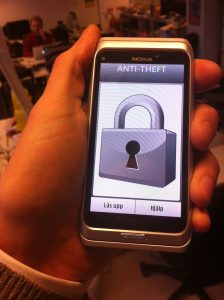
I have friends who religiously protect their laptops and pendrives with TrueCrypt, axCrypt, or similar, but still carry around an unencrypted mobile phone. What we’re talking about here is a device that contains all of the contact details for you and everybody you know, as well as potentially copies of all of your emails and text messages, call histories, magic cookies for social networks and other services, saved passwords, your browsing history (some people would say that’s the most-incriminating thing on their phone!), authentication apps, photos, videos… more than enough information for an attacker to pursue a highly-targeted identity theft or phishing attack.
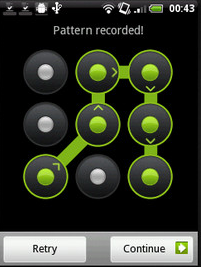
“Pattern lock” is popular because it’s fast and convenient. It might be good enough to stop your kids from using your phone without your permission (unless they’re smart enough to do some reverse smudge engineering: looking for the smear-marks made by your fingers as you unlock the device; and let’s face it, they probably are), but it doesn’t stand up to much more than that. Furthermore, gesture unlock solutions dramatically reduce the number of permutations, because you can’t repeat a digit: so much so, that you can easily perform a rainbow table attack on the SHA1 hash to reverse-engineer somebody’s gesture. Even if Android applied a per-device psuedorandom salt to the gesture pattern (they don’t, so you can download a prefab table), it doesn’t take long to generate an SHA1 lookup of just 895,824 codes (maybe Android should have listened to Coda Hale’s advice and used BCrypt, or else something better still).
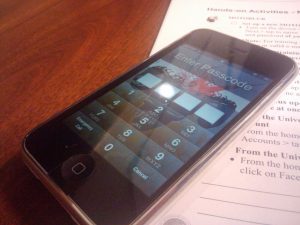
These attacks, though (and the iPhone isn’t bulletproof, either), are all rather academic, because they are trumped by the universal rule that once an attacker has physical access to your device, it is compromised. This is fundamentally the way in which mobile security should be considered to be equivalent to computer security. All of the characteristics distinct to mobile devices (portability, ubiquity, processing power, etc.) are weaknesses, and that’s why smartphones deserve at least as much protection as desktop computers protecting the same data. Mobile-specific features like “remote wipe” are worth having, but can’t be relied upon alone – a wily attacker could easily keep your phone in a lead box or otherwise disable its connectivity features until it’s cracked.
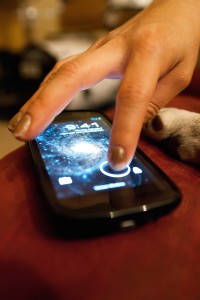
The only answer is to encrypt your device (with a good password). Having to tap in a PIN or password may be less-convenient than just “swipe to unlock”, but it gives you a system that will resist even the most-thorough efforts to break it, given physical access (last year’s iPhone 4 vulnerability notwithstanding).
It’s still not perfect – especially here in the UK, where the RIPA can be used (and has been used) to force key surrender. What we really need is meaningful, usable “whole system” mobile encryption with plausible deniability. But so long as you’re only afraid of identity thieves and phishing scammers, and not being forced to give up your password by law or under duress, then it’s “good enough”.
Of course, it’s only any use if it’s enabled before your phone gets stolen! Like backups, security is one of those things that everybody should make a habit of thinking about. Go encrypt your smartphone; it’s remarkably easy –
- Android
- iPhone – just enable PIN lock, but consider also encrypting your backups
- BlackBerry
- Windows Phone – encryption is “coming soon”, apparently.
Searching For A Virgin
You just can’t rely on GMail’s “contacts” search any more. Look what it came up with:

With apologies to those of you who won’t “get” this: the person who came up in the search results is a name that is far, far away, in my mind, from the word “virgin”.
In not-completely-unrelated news, I use a program called SwiftKey X on my phone, which uses Markov chains (as I’ve described before) to intelligently suggest word completion and entire words and phrases based on the language I naturally use. I had the software thoroughly parse my text messages, emails, and even this blog to help it learn my language patterns. And recently, while writing a text message to my housemate Paul, it suggested the following sentence as the content of my message:
I am a beautiful person.
I have no idea where it got the idea that that’s something I’m liable to say with any regularity. Except now that it’s appeared on my blog, it will. It’s all gone a little recursive.
What’s Wrong With My Phone
In my review of my new HTC Sensation earlier this month, I tried to explain how my new phone – with it’s swish and simple interface – didn’t feel quite… geeky enough for me. I picked up on the way that it’s process management works, but I’ve since realised that this is only symptomatic of a deeper problem. This is entirely to do with the difference between traditional computers (of which my old N900 was one) and modern consumer-centric devices (which, inspired by the iPod/iPhone/iPad/etc.) try to simplify things for the end-user and provide strong support for centralised repositories of pre-packaged “apps” for every conceivable purpose.

To take an example of the difference: my N900 ran Linux, and felt like it ran Linux. As a reasonably-sensible operating system, this meant that all of the applications on it used pretty much the same low-level interfaces to do things. If I wanted, I could have installed (okay, okay – compiled) sshfs, and be reasonably confident that every application on my phone, whether it’s a media player or a geocaching application or whatever, would use that new filesystem. I could store my geocaching .gpx files on an SSH-accessible server somewhere, and my phone could access them, and my geocaching app wouldn’t know the difference because I’d have that level of control over the filesystem abstraction layer.
Similarly, if I installed a game which made use of Ogg Vorbis to store its sound files, which therefore installed the Vorbis codecs, then I can expect that my media player software will also be able to make use of those codecs, because they’ll be installed in the standard codec store. This kind of thing “just works”. Okay, okay: you know as well as I do that computers don’t always “just work”, but the principle is there such that it can “just work”, even if it doesn’t always.
On these contemporary smartphones, like the iPhone, Android devices, and (I assume) modern BlackBerrys, the model is different: individual applications are sandboxed and packaged up into neat little bundles with no dependencies outside of that provided by the platform. If you have two applications installed that both use sshfs, then they both have to include (or implement) the relevant bundle! And having them installed doesn’t automatically give sshfs-like functionality to your other filesystem-accessing tools.
It’s not all bad, of course: this “new model” is great for helping non-technical users keep their devices secure, for example, and it means that there’s almost no risk of dependency hell. It’s very… easy. But I’m still not sure it quite works: I’ll bet that 90% of users would install an application that demands dubious levels of permissions (and could, for example, be stealing their address book data for sale to scammers) without even thinking about the risks, so the security benefits are somewhat nullified.
In summary:
| Pros | Cons | |
|---|---|---|
| Traditional-computing device (e.g. N900) |
|
|
| “New model” device (e.g. iPhone, Android) |
|
|
Needless to say, the new model devices are winning, and already tablet computers powered by the very same platforms as the mobile phones are beginning to be seen as a simpler, easier alternative to conventional laptops. It’s to be expected: most of today’s users don’t want a learning curve before they can use their smartphone: they just want to make some calls, play Angry Birds a bit, keep up with their Facebook friends, and so on. But I hope that there’ll always be room for a few folks like me: folks who want to tinker, want to play, want to hack code for no really benefit but their own pleasure… and without having to shell out for a developer license in order to do so!
A New Sensation
I’ve recently gotten a new phone – a HTC Sensation running Android 2.3, and I thought I’d offer up a few thoughts on it. But first…
Hang on: what was wrong with your old phone?
Well-remembered! You’re right, of course, that last year I got a Nokia N900, and that it was the best mobile communications device I’d ever owned. I don’t care so much about a slim profile or an “app store”, but I do care about raw power and geeky hardware features, and the N900 delivers both of those in spades. I’ve had several phones that have, at the time, been the “best phone I’ve ever owned” – my 7110 and my N96 both also earned that distinction, whereas my 7610 and my C550 – the latter of which had only one redeeming feature – fell far short.
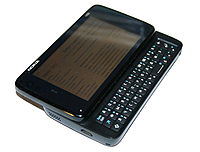
Awesome though it is, with it’s beautiful hardware keyboard, mighty processor, FM receiver and transmitter, Bluetooth and IR, etc., and completely unlocked, tamper-friendly architecture, the N900 suffers from one terrible, terrible flaw: for some reason, the engineers who built it decided to mount the Micro-B USB port (used for charging, tethering, mounting etc. the phone) not to the hard plastic case, but to the fragile inner circuit board. Allow me to illustrate:
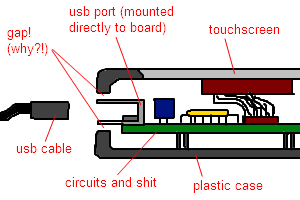
Why is this a problem? Well, as Katie explained to me at the New Earth housewarming party, most of her other friends who’d had N900s had encountered a problem by now, whereby the USB cable used to charge the device eventually puts a strain on the connection between the port and the board, tearing them apart. “Nope,” I told her, “I’ve never had any such problem with mine.”
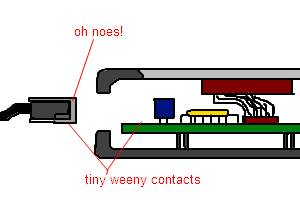
Looks like I spoke too soon, because that very week, I managed to break my N900 in exactly this way. My theory: that girl is cursed. I shall be attempting to exorcise the anti-technology demons in her the very next time I see her, possibly in some kind of ceremony involving high-voltage direct current. In any case, I found myself with a phone that I couldn’t charge.
So you replaced it?
No, of course not. My N900 remains a fantastic palmtop and a great device. It’s just got a minor problem in that it’s no longer possible to charge or “hard”-tether it to anything any more. The latter problem was an easy one to fix: a separate battery charger (I already carry a spare battery for it, so this was no hardship), bought for about £4 on eBay, made it easy to keep the device rolling. The second problem’s not so much of an issue, because I tend to do all of my synchronisation by Bluetooth and WiFi anyway. But even if these were an issue, it looks like a pretty simple job to re-solder the USB port (and epoxy it to the case, as it should have been to begin with!). I might give it a go, some day, but my current soldering iron is a little big and chunky for such fine and delicate work, and I’m a little out of practice, so I’ll save that project for another day.

However, I’m a big believer in the idea that when the Universe wants you to have a new phone, it finds a fault with your current phone. Perhaps this is the geek equivalent of thinking that “When God closes a door, He opens a window”.
So: I’ve got myself a HTC Sensation, which narrowly beat the Sony Ericsson Xperia Arc after carefully weighing up the reviews. I’d always planned that I’d try an Android device next, but I’d originally not expected to do so until Ice Cream Sandwich, later this year. But… when the Universe closes your USB Port, it opens a Gingerbread shop… right?
The New Sensation
After a few difficulties relating to my name – it turns out that my mobile phone network has recorded my name correctly in their database, and I can’t change it, but whenever I use their web-based checkout it asks me to enter a longer surname even though I don’t have a surname field to change – I finally received my new phone.

The first thing one notices about this phone is that it’s fast. Blindingly fast. I’ve used a variety of Android-powered HTC devices before, as well as other modern touchscreen smartphones like the iPhone, and I’m yet to use anything that consistently ramps up high-end graphics and remains slick and responsive like this does. Its mighty dual-core 1.2GHz processor’s the cause of this, little doubt. I originally worried that battery life might be limited as a result – I don’t mind charging my phone every night, but I don’t want to have to charge it during the day too! – but it’s actually been really good. Using WiFi, GPRS, GPS, playing videos, surfing the web, and other “everyday” tasks don’t put a dent in the battery: I’ve only once seen it dip to under 10% battery remaining, and that was after 40 hours of typical use during a recent camping weekend (with no access to electricity).
It’s also been really well-designed from a usability perspective, too. Those familiar with Android would probably just start using it, but I’ve not had so much exposure to the platform and was able to come to it with completely fresh eyes. Between Android 2.3 and HTC Sense 3, there’s a nice suite of “obvious” apps, and I didn’t have any difficulty synchronising my contacts, hooking up my various email accounts, and so on. There are some really nice “smart” touches, like that the phone rings loudly if it thinks it’s in a bag or pocket, more quietly after you pick it up, and silences the ringer completely if you pick it up from a table and flip it from face-up to face-down. These simple gestural touches are a really nice bit of user interface design, and I appreciate the thought that’s gone into them.

The Android Marketplace is reasonable, although I feel as though I’ve been spoiled. On the N900, if there was an application I needed, I usually already knew what it was and where I’d find it: then I’d either apt-get it, or download the source and compile it, right there on the device. For somebody who’s already perfectly confident at a *nix command-line, the N900 is fab, and it feels a little restrictive to have to find equivalent apps in a closed-source environment. It’s not that the pricing is unreasonable – most of the applications I’ve wanted have been under a quid, and all have been under £4 – it’s just that I know that there are FOSS alternatives that would have been easy to compile on my old device: I guess it’s just a transition.
On the other hand, the sheer volume of applications so-easily available as the Android Market is staggering. I’ve been filled with app ideas, but every idea I’ve had but one or two already exist and are just waiting to be installed. It’s a little like being a kid in a candy store.
It’s also taking me quite some time to get used to the way that process management works on an Android device. On Android devices, like the iPhone/iPad, returning to the home screen doesn’t (necessarily) close the application, but it might – that’s up to the developer. If it doesn’t, the application will probably be “paused” (unless it’s a media player or it’s downloading or something, then it’ll likely keep going in the background). And when you re-launch the same application, it could be simply unpausing, or perhaps it’s relaunching (in which case it may or may not restore its previous state, depending on the whim of the developer)… You see all of the keywords there: might, probably, likely, could, perhaps. Great for most users, who don’t want to have to think about what their phone is doing in the background, but it feels like a step backwards to me: I’m used to being able to ALT-TAB between my currently-running applications, to know what’s running, when (and I can always use top and find out exactly what resources a process is eating). Putting all of this process management into the hands of developers feels to me like giving up control of my device, and it’s a challenging change to undergo. Yes: despite the openness of the platform, Android feels just a little out of my control compared to what I’m used to.

Switching from a physical to a virtual keyboard for the first time is a significant change, too, and it’s slowed me down quite a lot, although applications like SwiftKey X – with its incredibly intelligent personalised predictions – and Hacker’s Keyboard – which gives me back some of the keys I was “missing” – have helped to ease the transition a lot.
In summary: the HTC Sensation seems to be a fantastic device, and I’m really enjoying using it. I’ve got a few niggles to contend with, but these are all things that were destined to catch me out upon switching away from a platform as open as the N900, and they’re not severe enough to make me give up and get an N950 instead: I’m reasonably confident that I’ll come to love the Sensation and we’ll go on to be very happy together.
But will it become my latest “best phone ever”? Time will tell, I guess.
Wrong Number
My phone rings. I answer.
Me: Hello?
Caller: Hello. Is that Mr. Wilburn.
Me: Steve Wilburn?
Caller: Yes.
Me: I’m afraid I don’t know anybody by that name.
My, she was confused when I knew the name of the person she wanted to get in touch with, and then claimed not to know them! I’d had a call the previous week from the same number, and the caller then had asked for Steve before identifying him by his full name.
If I get another call, I fully intend to cut out the “checking that they’re looking for ‘Steve'” part of the conversation and just state that I don’t know a Steve Wilburn. They’ll get the hint eventually.
And Steve? If you’re out there, mate – somebody wants you. I have no idea who they are… but then, I have no idea who you are, either. But if you could let them know the correct number to reach you on, that’d be appreciated. Ta.
Hollywood Pizza And BT Online Billing
If only BT.com online billing provided an XML feed… we could integrate our Hollywood Pizza order call times and lengths into the Troma Night web site.
Probably not a good thing, actually.
Smash My Phone
For $12.99, you can have a model smash your phone and publish the video to the internet for you to enjoy again and again. Fucking weird.
The Student Loans Company Are Wankers
[this post was damaged during a server failure on Sunday 11th July 2004, and it has not been possible to recover it]
[this post was partially recovered on 12 October 2018]
Well, they give me money, so I can’t complain too much, but regardless…
My student loan should have been credited to my account on Monday (12th). Paul got his on Sunday! But when mine hadn’t come through by this morning, I got a little concerned. So I phoned them up on the enquires number listed on their web site.
“You have called the Student Loans Company. For enquiries regarding your student loan, press 1. To change your bank account details, press 2. For any other enquires, press 3.”
I press 1.
“If you are calling on behalf of a third party, we must advise you that they must cal personally owing to customer confidentiality. If you have any general enquiries, please visit
our web site at www.slc.co.uk. Thank you.” <click>
WTF?
I call again, and this time press 3. Some confusing buttons later, I get through to a nice Scottish woman called Alison. It turns out that they had the incorrect sort code for me (and they had known this for several months [sort code had come up invalid upon entry] – but hadn’t bothered to phone or write to me). How had they gotten the sort code wrong? Well; they’d read one of my …
